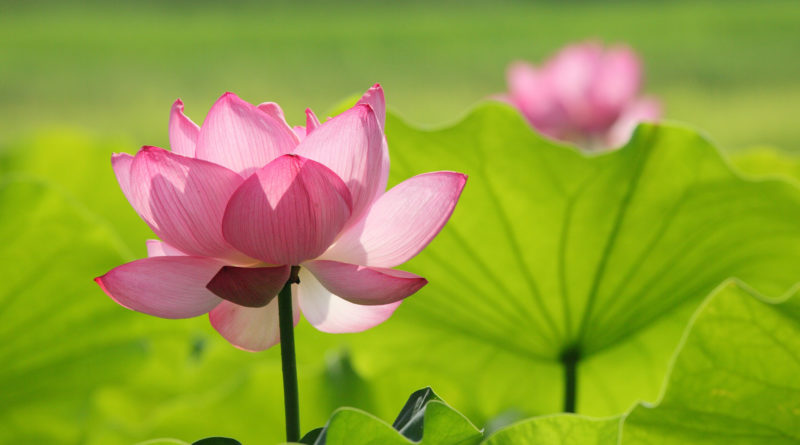BEGINNINGS: THE PALI SUTTAS – PART VIII: THE FIFTH NIKAYA
BEGINNINGS: THE PALI SUTTAS – PART VIII: THE FIFTH NIKAYA
In the entire Vana Samyutta (IX (i,197-205)) we find no mention of the Buddha. And all but one of these fourteen discourses take place in Kosala. The monks living in the woods (vana) of Kosala apparently managed to get their own local tradition, much involved with deities, included in the Canon. So apparently did the followers of Venerable Sariputta, for although elsewhere in the Nikayas he is found frequently in discussion with the Buddha, in the Sariputta Samyutta (XXVIII (iii,235-40)) none of the ten discourses make mention of the Teacher; nine of them take place in Savatthi. Similarly the four consecutive Samyuttas (XXXVIII-XLI) named after, respectively, the wanderers Jambukhadaka and Samandaka, each containing sixteen conversations with Venerable Sariputta, the first set entirely in Magadha, the second among the Vajjians; Venerable Maha Moggallana, eleven discourses, all set in Savatthi, and the lay disciple Citta, ten discourses, all set at Macchikasanda, are apparently later additions to the Samyutta Nikaya of discourses already in existence when the First Council met, but not compiled by them. It should be noted that the Suttas concerned with Citta clearly reveal attitudes of lay devotees rather than of monks.
And there are further examples in both the Samyutta and Anguttara Nikayas; but we need not investigate them, for we can see by now that the method whereby any new material could be inserted into the collections had to involve a consensus as to its suitability and also to include in each case a “warning label” — “Venerable So-and-so was dwelling at…” — that the discourse is not part of the original compilation. There are about 200 such discourses, filling roughly 350 pages of print, which is about six per cent of the total.
And by the same evidence we can know that neither was any material lost nor were any of the Suttas arbitrarily altered. For exactly the same mechanism that required consensus in order to add to the Canon would have come into force had any attempt been made to alter a text. And we can well imagine the difficulty, the virtual impossibility from the very outset, of such a consensus being achieved in order to alter what had been laid down by those very monks who were venerated as the founders of the various lineages (see S. XIV,15 (ii,155-7)).
In order for any Sutta or part of a Sutta to have been lost, we should have to suppose either a collective amnesia among all the monks of all the companies who were reciters of that Sutta — hundreds, or more probably thousands of ambulatory amnesiacs! — or else the breaking up and disappearance of every single company responsible for a certain portion of the Suttas — and this in a time when all the evidence indicates that the Order was thriving and growing — together with the refusal or inability of any single monk (or ex-monk) from any of those lost companies to come forward to teach the texts to the surviving groups. A most improbable combination of events! No, the evidence shows clearly that there were additions to the texts, but to suppose either substantial changes or losses is contrary to reason.
It must be emphasized primarily for the benefit of scholarly readers that we did not begin by assuming that Suttas which do not refer to the Buddha in their introductory material are therefore later additions to the Canon. Rather, we first discovered a few Suttas that certainly describe events that had taken place after the Buddha’s decease. Examining them, we noticed that they possessed one feature in common and in distinction to the great majority of discourses. We then looked at other texts which also displayed this feature and found therein further grounds to accept that those texts, too, were probably later additions to the Canon. We described in detail the evidence found in several of these texts and indicated in brief other Suttas providing additional evidence; but we do not propose to present the data to be found in a number of other texts, for to do so would require a very long and technical and uninteresting digression. We will note only that this evidence consists of a large number of small, and a few not-so-small, points, all tending in the same direction, with no cases of an opposite tendency.[35]
For how long did this process of slow accretion continue? We can be quite certain that by the time of the Second Council which met a century after the Buddha’s decease, the process had already ended, the four Nikayas being regarded as closed, and that this view was ratified and finalized by that Council. The evidence:
All additional Suttas involve “first generation” monks, i.e. contemporaries of the Buddha but who, in some cases, outlived the Teacher.[36] The only instance which can reasonably be considered an exception is that of Venerable Narada, whose talk with King Munda — Ajatasattu’s great-grandson, according to later accounts — is recorded at A. V,50 (iii,57-62). However, even in this case we have a discourse at S. XII,68 (ii,115-8) — clearly earlier than the Anguttara Sutta, for there he is said to be already a worthy one (arahat), i.e. fully liberated, whereas here he is self-described as not yet arahat, still a sekha — where Venerable Ananda also has a part. So if Venerable Narada was not contemporaneous with the Buddha, he was at least not far from it. Venerable Narada’s discourse to King Munda is, as we have it, identical to a discourse to the monks spoken by the Buddha: A. V,48 (iii,54-56).
Later sources tell us that it was during the time of Kalasoka, the third Magadhese king after Munda, that the Second Council convened. The Vinaya’s description of this Council is much more detailed than, and about twice the length of, its report on the First Council. The impetus for the meeting was the exposure and condemnation of certain relaxations of monastic discipline which had arisen among a company of monks centred in Vesali, the famous “ten points”, the most important of which concerned a relaxation of the prohibition against “accepting, using, or consenting to the deposit of money”. We are told of the politicking that went on before the Council met, and we are introduced to the main players in that drama, the leading monks of the day. Not one of these eight monks nor any of the lesser monks mentioned is known to the four Nikayas. If the four Nikayas had been then regarded as open to additional material, surely we would expect to find these monks represented.[37]
What happened is clear: however highly these monks might have been regarded individually, for of course some of them would have achieved full purification, those monks who were not contemporaries of the Buddha could never achieve the distinction of those who had known him personally. Later monks belonged, inevitably, to a particular lineage which (like caste) could not be transcended. Only the founding elders, those who had established the lineages, could be regarded as beyond those lines. If the doings and sayings of these second generation monks were admitted to the Nikayas, where would it end? The decision that needed to be reached if the Nikayas were to survive at all was that with the passing of the first generation the collections had to be closed. Had they been left open they would have become amorphous and protean — not to be confused with “rich and varied”! — and would have lost their very purpose. Therefore whatever pressures may have developed to incorporate this or that “second generation” discourse needed to be opposed and obviously were.
The Fifth Nikaya
The material which was admitted to the Four Nikayas during the first century after the Buddha was but a fraction of what was remembered. Much of this material, which included a great deal of verse,[38] must have been in common circulation, the preserve of no single lineage or group of companies; for within the four Nikayas and also within the Vinaya we find not only one Sutta referring to another[39] but also, here and there, Suttas referring to material which lies outside the first four Nikayas.[40] There was also new material being generated to fulfil new needs as with the Payasi Sutta on rebirth, or to describe new events as with Ven. Narada’s talk to King Munda. What was to be done with all of this? To add substantially to the Nikayas would have established an unfortunate precedent leading to the inevitable dissipation of their integrity; yet to leave the material disorganized would be to abandon much that was worthy to an early destruction. The solution chosen was the creation of the fifth collection, the Khuddaka Nikaya.
Khuddaka means “small” and at first the Khuddaka Nikaya was indeed small. Today, with fifteen separate sections, it is the most voluminous of the Nikayas, but originally it consisted of probably six or seven separate short texts, each of which had been compiled and preserved, prior to inclusion in the Nikaya, individually on its own merits.
The Theragatha and Therigatha, for instance, consist of the verses of various monks and nuns, respectively. Here there can be no doubt that some of the verses are by second generation disciples (e.g. Venerable Parapariya’s verses, 920-948), and that the texts grew substantially after the First Council. This is only to be expected: the two collections do not pretend otherwise. The Dhammapada is a collection of popular verses. Quite a few are to be found elsewhere among the Suttas, but as many or more are unique to this compilation. Most of the verses stand alone, unconnected to the others. We have no direct evidence as to the date of its closure, but the arrangement and distribution of the verses suggest that it could well have grown during the first century. The Sutta Nipata is, like the Dhammapada, a collection of popular verse, but it differs in that its verses form longer poems, each of which is regarded as a discourse. Indeed, some of them have prose attached, as a sort of introductory bunting. A few of the poems appear within the four Nikayas; the remainder are the most popular of those longer poems that are not included therein. As such, a number of its passages are quoted within the four Nikayas (as noted above), which has given rise to the mistaken view that the Sutta Nipata contains the “oldest layer” of texts. Certainly some of the Sutta Nipata texts are contemporaneous with the first four Nikayas, but they do not pre-date them.[41]
The Udana is a collection of eighty solemn utterances spoken by the Buddha on special occasions. The Itivuttaka contains 112 short Suttas, each accompanied by verses, the relevance of which is not always apparent. This fact together with some seeming textual corruptions suggest that it may have had an older and independent life before being incorporated into the Khuddaka Nikaya. If this is so, it indicates what happened to those texts that did not receive the formal protection of organization.
“The Jataka contains only the verses connected with the 547 tales of previous existences of the Buddha. The (prose) tales are in a commentary of the fifth century A.D., which claims to be translated from Sinhalese (to Pali)….
Professor T. W. Rhys Davids has stated that these tales are ‘old stories, fairy tales, and fables, the most important collection of ancient folklore extant,’ which we are not able to deny.”[42]
Since the Jataka verses are often incomprehensible without the prose commentary, it is difficult to see how they could predate the prose. The prose, however, would predate the fifth century commentary into which it was translated and collected. The origin of these verses, then, remains indeterminate. It is sometimes thought that since these three texts — Udana, Itivuttaka, Jataka — are mentioned as part of the ninefold description of texts (see above) that they must be, like the Sutta Nipata, part of “the oldest layer” of texts that we now have; but it is more reasonable to suggest that they were so named because the ninefold description was already in existence.
The other eight texts that are today included within the Khuddaka Nikaya are generally regarded as late additions, and need not be discussed.
The formation of this collection probably arose during the century between the two Councils rather than with the Second Council itself: such developments need time to generate strength and achieve general acceptance. By the time the Council assembled, the force of opinion would have already been in favour of including this new collection in the Canon: the Council’s function herein would have been to ratify and reinforce this consensus and, no doubt, to decide upon its organizational details. They would also have had a hand in deciding final organisational details for the other Nikayas and for the Vinaya. It was possibly at this time, for example, that D. 16 — see Preface, paragraph six — was expanded to its present form, or at least a previous expansion was at this time ratified, by including passages taken from the other parts of the Nikayas. And, too, those few texts, the “six percent” which had been added to their collections by the various bhanakas, would have been cast now into their final forms.[43]
It needed to be done, for the monks of the Vesali company, along with their supporters, seem (according to a non-Canonical text, the Dipavamsa, vv. 32ff.) to have refused to accept the ruling of the Council, breaking away and forming their own council, wherein they re-arranged and, it seems, added to the texts to suit their own purposes. During the next 250 years this company split up and resplintered into numerous factions, each having evolved its own set of doctrines and disciplinary codes.[44] None of these texts have survived: again, as with Venerable Purana, we learn the survival-value of organization.[45] The fact that the Suttas and Vinaya[46] have survived as coherent entities can now be seen to be itself strong evidence that they have survived unchanged.








